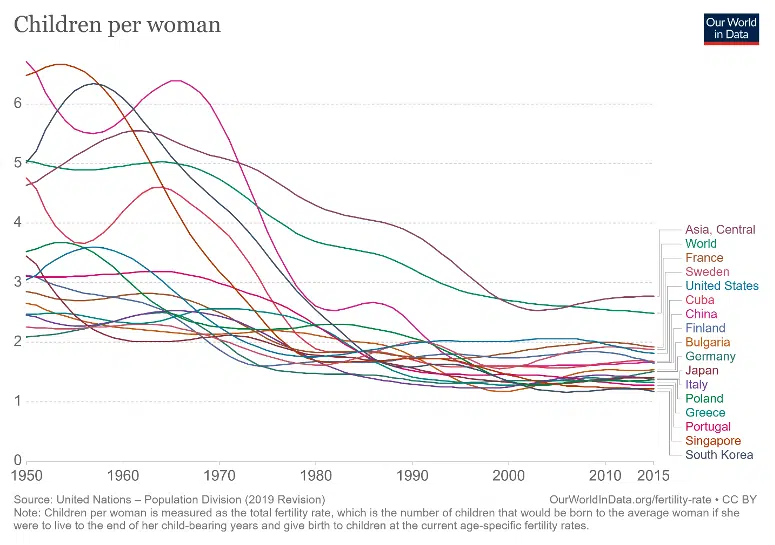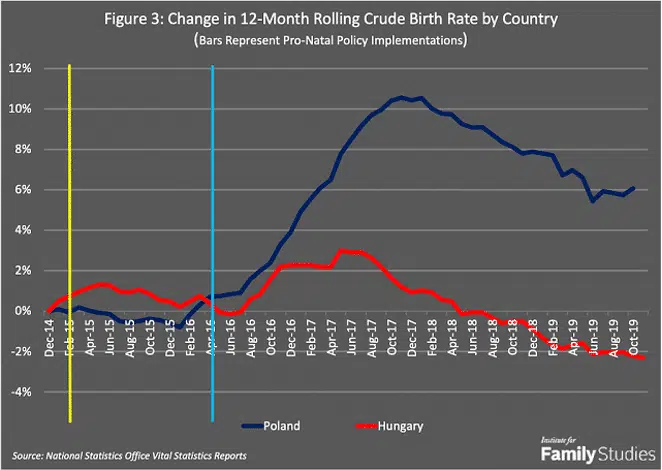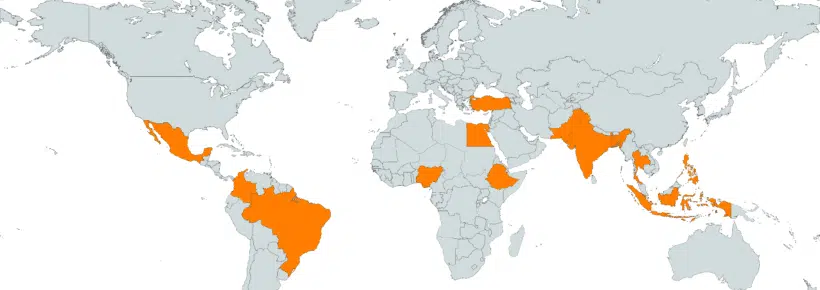In 2014 in Fourni, Greece, not one single baby was born. The same was true in 2015. In 2012, only one child was born in the town of Lestijärvi, Finland.
What is happening in these countries is not an anomaly. Countries throughout Europe are seeing population declines that their governments are trying desperately to reverse. In fact, many governments, and even companies, are now offering incentives for families to have more babies. These pronatalist policies—policies or practices that “encourage the bearing of children”—are becoming increasingly prevalent as countries battle declining birthrates and an aging population.
We know that babies are an incredible blessing. However, not all people believe or understand that. It seems our world is divided between people who want to restrict the number of births and people who see the value in every baby.
Antinatalism
Antinatalism is the belief that humans should stop procreating. Some people believe that, for economic, environmental, or social reasons, humans should cease to exist. Further, they see the suffering that humans sometimes go through as useless. They believe it should be avoided at all costs.
For various reasons, other groups want to reduce population and limit family size. The most predominant among these reasons is the environment. In an article on population control, HLI’s Brian Clowes, PhD, wrote that many countries have taken drastic measures. He states: “We have witnessed forced abortion and sterilization programs in China, Vietnam, Peru and many other countries, partly in support of programs to preserve the environment. There have been vast numbers of women sterilized or fitted with IUDs without their knowledge or consent for the same reason.”

Source – Our World in Data
But now countries are starting to see the inherent flaws in their anti-baby reasoning. Birth rates are far below replacement level in many countries. “Replacement level” is the birth rate needed to replace a population from one generation to the next. This is usually calculated as 2.1 children per woman in developing countries. According to The Lancet, “Fertility is declining globally, with rates in more than half of all countries and territories in 2021 below replacement level.”
Further, a recent article published by the Institute for Health Metrics and Evaluation claims that “by 2050, over three-quarters (155 of 204) of countries will not have high enough fertility rates to sustain population size over time.”
Why is This Problematic?
In order to thrive, countries must stay at or above replacement levels. In developed countries where the birth rate is low, the population of elderly people is rising faster than the number of births. Thus, there are not enough people to replace the elderly in the workforce. And there are too few people to take care of them. In addition, in countries like China, where its now-rescinded one-child policy was in effect for many years, there is a shortage of women, as families either aborted or abandoned their baby girls.
A Development Aid article lists 20 of the fastest-shrinking countries in the world. These include Italy, Cuba, and Portugal, each with about a 10% drop expected in the next 25 years. Romania, Japan, Croatia, and Serbia all have about a 15 – 20% drop projected. Bulgaria ranks number one on the list. It has nearly a 23% drop in population projected by 2050.
It’s not just bad news for foreign countries. The Centers for Disease Control recently reported that the birth rate in America has “decreased by 3% from 2022, reaching a historic low.”
So how do we rectify the situation? How do we, as a global community, encourage people to have babies? And how do we support growing families?
Pronatalist Policies
First, we must become a global society that values babies as human beings not as commodities. Part of valuing them is caring for them before and after they are born. This value extends to their parents as well.
As St. John Paul II said in a 1986 homily: “As the family goes, so goes the nation, and so goes the whole world in which we live.”
Motherhood is a tough but incredibly rewarding job. Women are the only people who can carry a new life inside them and then give birth to an entirely new human being. For this, they should be revered, respected, and cherished. We need mothers to keep populations from declining and to bring good into the world. Many say that those who encourage women to have children are living in a world where women are just “baby-making machines,” akin to the women in the fictional story The Handmaid’s Tale, where women are forced to carry babies and repopulate the world. But that is not the reality behind pronatalism and the love of babies.
Pronatalists would not encourage rape or the submission of women to sexual advances by men to increase pregnancy rates. Pronatalism means breaking down the fears (which are mostly financial) of women and families, offering financial and material assistance, and changing the mindset that babies are commodities that can be discarded at will.
Some countries have begun incentive programs to encourage people to have more children. And, in many of these countries, the incentives include much more than money. They include time.
In the 1960s and 1970s South Korea’s government pushed its women to have two or fewer children. Since then, and despite recent incentives, its fertility rate has been below one. This is one of the lowest in the world. The country has spent more than $180 billion over the last 10 years to encourage people to increase family size. Even some companies have stepped in to help:
- Posco gives two choices to its women employees who have just had a baby: they can choose between a year of paid leave and a two-year program where they spend only half the day in the office.
- A construction management company called HanmiGlobal Co. offers employees financial incentives for having children. It gives three million won (roughly $2,700) for having a third child. And it gives five million won (about $4,500) for a fourth child. In addition, mothers get six months of leave after giving birth. Further, the company pays the child’s tuition from kindergarten to university, regardless of how many children are in a family.
The small Finnish town of Lestijärvi saw just one birth in 2012. That prompted town officials to begin a baby incentive. Each baby born would get 10,000 euros, paid over 10 years. Finland has also implemented programs to help babies get off to a good start. These include a “baby box.” This box is sent to every woman, regardless of income or economic status. It includes clothes and other useful items. Further, Finland’s prime minister instituted a new parental leave policy after the birth of a child. It states:
Parental leave lasts for 320 working days, i.e. approximately 14 months. If the child has two parents, both of them are entitled to 160 working days of leave. A parent may give up a maximum of 63 parental leave days to the child’s other parent. The person to whom the days are given up is entitled to parental leave for those days. A single parent can use all 320 working days.
Poland has also taken action to increase birth rates. In 2016, it launched a program entitled Family 500+. Not only is this program aimed at increasing birth rates, but it also aims to decrease childhood poverty. Plus, it attempts to improve the living conditions of large families. As a result, Poland saw a 13 – 15 percent increase in childbirth between December 2016 and January 2017 compared to the same time frame in previous years, and to date it has helped over six million children.
In Greece, 36% of the country’s population is expected to be over 65 by 2050. To incentivize births, the government gives parents of newborn babies 2,000 euros. According to the Deputy Minister of Labor and Social Affairs: “People might think this is an issue of national pride but it’s actually one of national preservation.” She continues: “Given that high productivity rates are associated with young populations and not actively aging ones, it’s also an economic growth priority.”
As for the tiny grouping of Greek islands called Fourni, which had no births in 2014 and none in 2015? Medical services and incentives have encouraged its residents to have babies. As of February 2020, there were 11 pregnancies.
Japan has its highest fertility rate in over 20 years. It attributes this increase to “cash incentives for having children.”
In 2023, Hungary passed a new incentive to mothers. According to Business Insider, “Women in Hungary who become mothers under the age of 30 ‘will be exempt from paying personal income tax’ for the rest of their lives.”
What about leave policies here in the US? In 2019, UNICEF conducted a study of 31 wealthy nations. Out of all these nations, the US was the only one that did not have a national leave policy for fathers or mothers.
Do Financial Incentives Work?
Writing for the Institute for Family Studies, author Lyman Stone explained that some incentives work and that “more money does yield more babies. . . . But it takes a lot of money.” Stone continued:
Truth be told, trying to boost birth rates to replacement rate purely through cash incentives is prohibitively costly. . . .
This doesn’t mean policymakers shouldn’t expand child benefits, which have many purposes, including reducing child poverty. It simply means that any pro-natal policy agenda will have to be about more than just a child tax credit. It’s vital that policymakers also think about how they can remove obstacles to marriage, facilitate access to decent housing, and accelerate completion of education—all vital elements in the modern economic life cycle leading up to childbearing. Without such a broad approach, pro-natal efforts will involve spending a great deal of money without a lot of results to show for it.
Research has shown that financial barriers such as lack of money for childcare, the rising cost of college, and skyrocketing housing costs keep people from having the number of children they want. This seems to be an impediment that holds no matter which country people live in.

Source – Institute for Family Studies
According to a Vox article, the financial incentives are not enough because people have had a change in attitude about family and children. It states:
One reason may be that decisions around childbearing are influenced by larger social factors that are outside the scope of government policy — including the growing number of choices people have about how to spend their lives. As education and economic productivity have increased over time, the “opportunity cost” of having a child has grown as well, said Cohen, the sociology professor. “People, especially women, have more lucrative things to do.”
In essence, people are putting money and material things in front of family.
That is why people must be taught to understand the inherent value of babies and families. If they do not, incentives often become pointless. We need to instill a mindset change. And that begins when babies are first created. For too long, we have lived in a world that cares very little about a tiny preborn baby.
But there is a better way.
The Inherent Value of Babies
Children are immense gifts from God. Most people of faith believe this. But you don’t have to profess a faith to understand that babies are a blessing and that families are vital to the health of a society.
While a government’s financial and economic policies make a difference on a larger scale, religious teachings and practices that espouse the dignity of the human person influence people on a deeper level. These are the truths that will eventually make a difference. These are the truths that will change mindsets.
But people have to listen. And people have to act. Too often, these words fall on deaf ears. So we have to chip away. We have to encourage strong marriages. We have to encourage employers to value the women who work for them as women and mothers. We have to teach women that, if they choose to stay home with their children, they have become a valuable resource. We have to build an understanding of education based on the inherent dignity of the person. And because there will always be women facing unexpected pregnancies, we have to keep funding places that help them. Places like St. Gianna’s Maternity Home or Foundations for Life help mothers develop the skills—both parenting and job-related—to succeed in life.
Conclusion
So, while there are vast differences between what pronatalist policies and pronatalist beliefs offer a society, both are necessary. A government that helps parents is a great thing. But a government that fosters a respect for life is even greater. People look to government for guidance. If that guidance involves a respect for life, the people will begin to also adopt that respect.
When the human race, as one body, pulls together to work for the betterment of all people, society will flourish. When a government cares for the people it governs, our world will become a better place. When companies give their employees time off or the ability to work from home, families will thrive. When education is valued so that people can improve their skills and increase their levels of independence, productivity will increase. And when people see the value in monogamous and faithful relationships, the human race will prosper.
The family is the cornerstone of society. A better future will not come to a society that does not value human life.
This article was originally published in January 2021 and was most recently updated in June 2024 by Susan Ciancio.
Read more:
Related Content
Susan Ciancio has a BA in psychology and a BA in sociology from the University of Notre Dame, with an MA in liberal studies from Indiana University. Since 2003, she has worked as a professional editor and writer, editing both fiction and nonfiction books, magazine articles, blogs, educational lessons, professional materials, and website content. Fourteen of those years have been in the pro-life sector. Currently Susan writes weekly for HLI, edits for American Life League, and is the editor of its Celebrate Life Magazine. She also serves as executive editor for the Culture of Life Studies Program, an educational nonprofit program for k-12 students.









